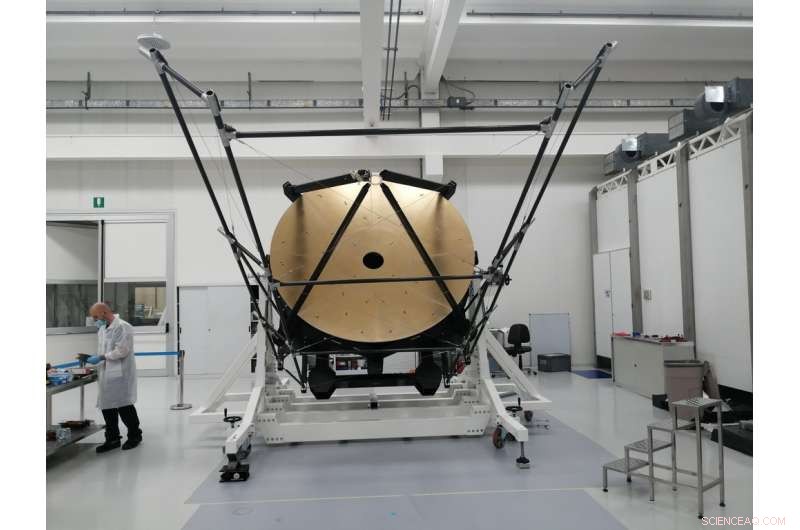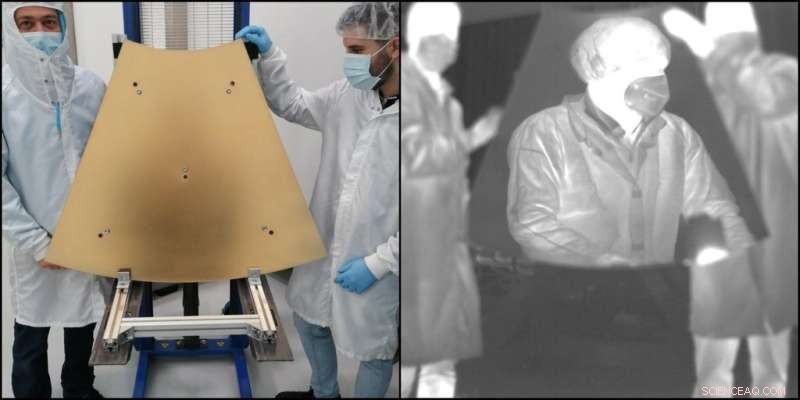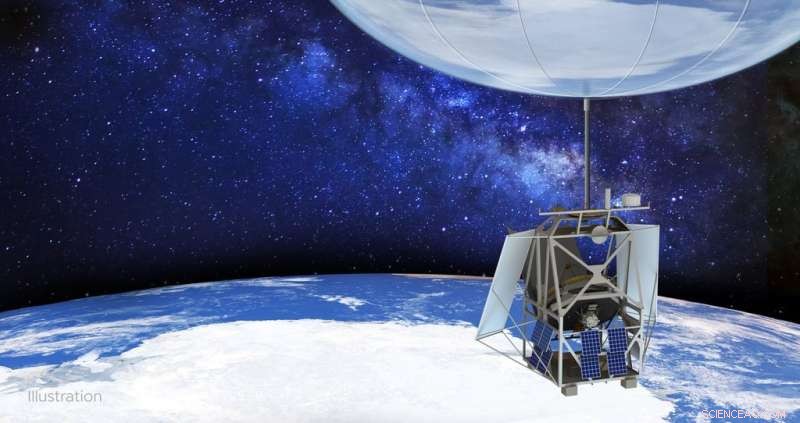
ASTHROS-uppdragets primära spegel är en av de största som någonsin flugit på en höghöjdsballong. Den lätta spegeln är belagd med guld och nickel för att göra den mer reflekterande i långt infraröda våglängder. Kredit:Media Lario
Teleskop som är konstruerade för att fungera i rymden måste konstrueras annorlunda än de som är avsedda att fungera på marken. Men hur är det med teleskop som fungerar däremellan?
Ett kommande NASA-uppdrag kommer att använda en ballong som är större än en fotbollsplan för att skicka ett teleskop 130 000 fot (cirka 40 000 meter) över Antarktis. Från den höjden kommer teleskopet att studera ett fenomen som stryper stjärnbildningen i vissa galaxer och effektivt dödar dem.
Uppdraget, kallat Astrophysics Stratospheric Telescope for High Spectral Resolution Observations at Submillimeter-wavelengths, eller ASTHROS, kommer att använda en primär spegel (det här teleskopets huvudsakliga ljusinsamlingsverktyg) som är bunden till den största någonsin att flyga på en höghöjdsballong. Konstruktionen av den 8,2 fot (2,5 meter) spegeln avslutades denna månad. Att designa och bygga den visade sig vara utmanande på grund av två nyckelkrav:Spegeln och dess stödstruktur måste vara exceptionellt lätta för att kunna resa med ballong, men ändå tillräckligt starka för att hålla dragkraften från jordens gravitation från att deformera dess nästan perfekta paraboliska form med mer än cirka 0,0001 tum (2,5 mikrometer) – en bråkdel av bredden på ett människohår.
ASTHROS, som drivs av NASA:s Jet Propulsion Laboratory i södra Kalifornien, är inställd på att lanseras tidigast i december 2023 och cirkulera sydpolen i upp till fyra veckor. NASA:s vetenskapliga ballongprogram, som drivs av myndighetens Wallops Flight Facility i Virginia, lanserar 10 till 15 ballonguppdrag varje år. Dessa uppdrag kostar vanligtvis mindre än rymduppdrag och tar mindre tid att gå från tidig planering till utplacering, och de använder ny teknik som kan användas i framtida rymduppdrag.

De guldfärgade ASTHROS-spegelpanelerna ser suddiga ut för blotta ögat, som ses till vänster. Men när den fotograferas med en infraröd kamera, som till höger, reflekterar panelen en teknikers bild lika tydligt som om personen tittade i en spegel. Kredit:Media Lario
Högt upp i stratosfären kommer ASTHROS att observera våglängder av ljus som blockeras av jordens atmosfär, i ett område som kallas långt infrarött. Dess stora spegel kommer att förbättra teleskopets förmåga att observera svagare ljuskällor och lösa upp finare detaljer i dessa källor.
Dessa förmågor är väsentliga för uppdragets tillvägagångssätt för att studera stjärnfeedback, processen genom vilken moln av gas och damm - ingredienserna för att göra stjärnor - sprids i galaxer, ibland till den grad att stjärnbildningen stoppas helt. Många processer bidrar till återkoppling, inklusive utbrott från levande stjärnor och explosiva dödsfall av massiva stjärnor som supernovor. ASTHROS kommer att titta på flera stjärnbildande regioner i vår galax där dessa processer äger rum, vilket skapar högupplösta 3D-kartor över gasens distribution och rörelse. Uppdraget kommer också att titta på avlägsna galaxer som innehåller miljontals stjärnor för att se hur feedback utspelar sig i stor skala och i olika miljöer.
"It's difficult to explore feedback all the way from where it originates, at the scale of individual stars, to where it has an effect, on the scale of galaxies," said Jorge Pineda, principal investigator for ASTHROS at JPL. "With a large mirror we can connect those two."

Lofted by a stratospheric balloon, as shown in this illustration, NASA’s ASTHROS mission may reach an altitude of 130,000 feet (40 kilometers). From that height, the telescope can detect wavelengths of light that are blocked by Earth’s atmosphere and cannot be observed from the ground. Kredit:NASA/JPL-Caltech
Meeting the challenge
NASA contracted Media Lario, an optics company in Italy, to design and produce ASTHROS's full telescope unit, including a primary mirror, secondary mirror, and supporting structure (called the cradle). Media Lario had previously developed a unique method for manufacturing lightweight infrared and optical telescope mirrors, which the company used to produce many of the panels for the primary mirrors of the Atacama Large Millimeter Array, a group of 66 ground-based telescopes in Chile.
The ASTHROS primary mirror features nine panels, which are significantly easier to fabricate than a one-piece mirror. The bulk of the mirror panels consist of lightweight aluminum, formed into a honeycomb structure that reduces its total mass. The panel surfaces are made of nickel and coated with gold, which improves the mirror's reflectivity at far-infrared wavelengths.
Because the ASTHROS team won't be able to fine-tune the alignment of the panels once the telescope lifts off, the cradle supporting the mirror needs to be lightweight yet exceptionally strong and rigid to prevent any deformation. Carbon fiber would do the trick. So, to build the cradle and other structural components, Media Lario turned to local companies in Italy that typically produce specialized structures for competitive racing boats and cars.
"I think this is probably the most complex telescope ever built for a high-altitude balloon mission," said Jose Siles, the ASTHROS project manager at JPL. "We had specifications similar to a space telescope but on a tighter budget, schedule, and mass. We had to combine techniques from ground-based telescopes that observe in similar wavelengths with advanced manufacturing techniques used for professional racing sailboats. It's pretty unique."
Media Lario will deliver the full telescope unit to NASA in late July. After that, the ASTHROS team will integrate it with the gondola (the structure that holds the entire payload and attaches to the balloon) and other key components. Then they'll begin a series of tests to ensure everything is ready for flight. + Utforska vidare